transmission oil FORD E SERIES 2023 Owners Manual
[x] Cancel search | Manufacturer: FORD, Model Year: 2023, Model line: E SERIES, Model: FORD E SERIES 2023Pages: 292, PDF Size: 6.81 MB
Page 6 of 292
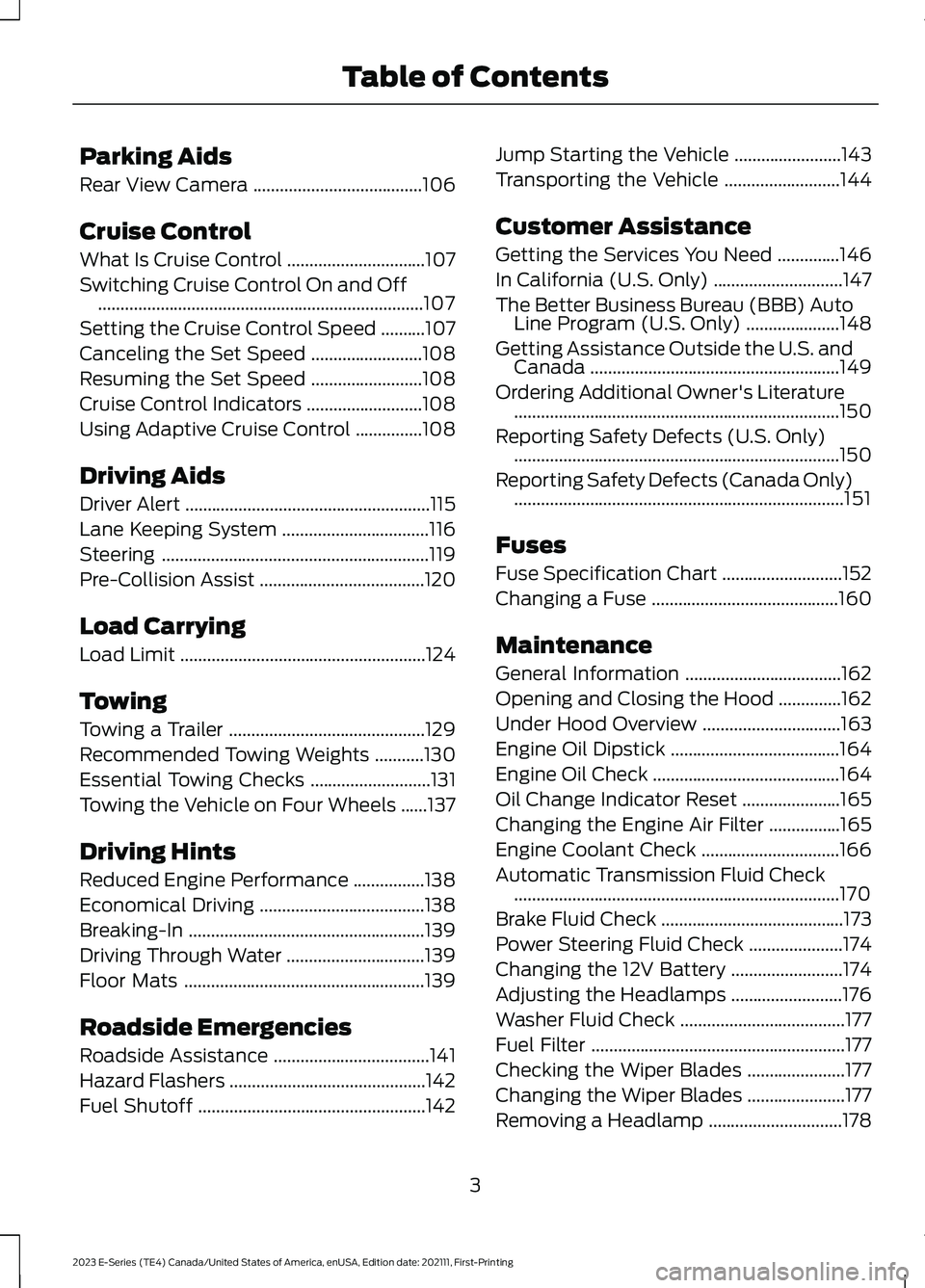
Parking Aids
Rear View Camera......................................106
Cruise Control
What Is Cruise Control...............................107
Switching Cruise Control On and Off.........................................................................107
Setting the Cruise Control Speed..........107
Canceling the Set Speed.........................108
Resuming the Set Speed.........................108
Cruise Control Indicators..........................108
Using Adaptive Cruise Control...............108
Driving Aids
Driver Alert.......................................................115
Lane Keeping System.................................116
Steering............................................................119
Pre-Collision Assist.....................................120
Load Carrying
Load Limit.......................................................124
Towing
Towing a Trailer............................................129
Recommended Towing Weights...........130
Essential Towing Checks...........................131
Towing the Vehicle on Four Wheels......137
Driving Hints
Reduced Engine Performance................138
Economical Driving.....................................138
Breaking-In.....................................................139
Driving Through Water...............................139
Floor Mats......................................................139
Roadside Emergencies
Roadside Assistance...................................141
Hazard Flashers............................................142
Fuel Shutoff...................................................142
Jump Starting the Vehicle........................143
Transporting the Vehicle..........................144
Customer Assistance
Getting the Services You Need..............146
In California (U.S. Only).............................147
The Better Business Bureau (BBB) AutoLine Program (U.S. Only).....................148
Getting Assistance Outside the U.S. andCanada........................................................149
Ordering Additional Owner's Literature.........................................................................150
Reporting Safety Defects (U.S. Only).........................................................................150
Reporting Safety Defects (Canada Only)..........................................................................151
Fuses
Fuse Specification Chart...........................152
Changing a Fuse..........................................160
Maintenance
General Information...................................162
Opening and Closing the Hood..............162
Under Hood Overview...............................163
Engine Oil Dipstick......................................164
Engine Oil Check..........................................164
Oil Change Indicator Reset......................165
Changing the Engine Air Filter................165
Engine Coolant Check...............................166
Automatic Transmission Fluid Check.........................................................................170
Brake Fluid Check.........................................173
Power Steering Fluid Check.....................174
Changing the 12V Battery.........................174
Adjusting the Headlamps.........................176
Washer Fluid Check.....................................177
Fuel Filter.........................................................177
Checking the Wiper Blades......................177
Changing the Wiper Blades......................177
Removing a Headlamp..............................178
3
2023 E-Series (TE4) Canada/United States of America, enUSA, Edition date: 202111, First-PrintingTable of Contents
Page 7 of 292
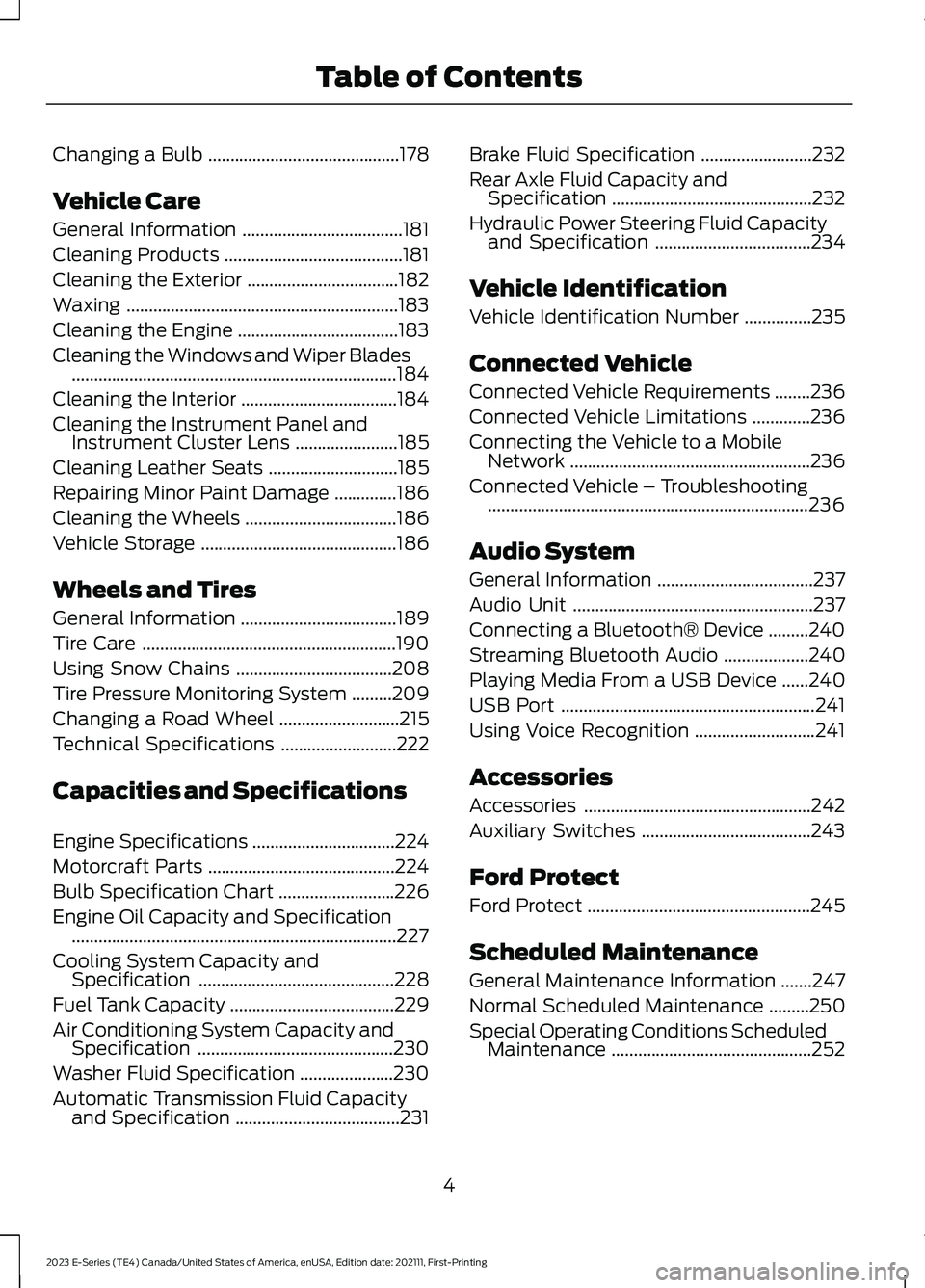
Changing a Bulb...........................................178
Vehicle Care
General Information....................................181
Cleaning Products........................................181
Cleaning the Exterior..................................182
Waxing.............................................................183
Cleaning the Engine....................................183
Cleaning the Windows and Wiper Blades.........................................................................184
Cleaning the Interior...................................184
Cleaning the Instrument Panel andInstrument Cluster Lens.......................185
Cleaning Leather Seats.............................185
Repairing Minor Paint Damage..............186
Cleaning the Wheels..................................186
Vehicle Storage............................................186
Wheels and Tires
General Information...................................189
Tire Care.........................................................190
Using Snow Chains...................................208
Tire Pressure Monitoring System.........209
Changing a Road Wheel...........................215
Technical Specifications..........................222
Capacities and Specifications
Engine Specifications................................224
Motorcraft Parts..........................................224
Bulb Specification Chart..........................226
Engine Oil Capacity and Specification.........................................................................227
Cooling System Capacity andSpecification............................................228
Fuel Tank Capacity.....................................229
Air Conditioning System Capacity andSpecification............................................230
Washer Fluid Specification.....................230
Automatic Transmission Fluid Capacityand Specification.....................................231
Brake Fluid Specification.........................232
Rear Axle Fluid Capacity andSpecification.............................................232
Hydraulic Power Steering Fluid Capacityand Specification...................................234
Vehicle Identification
Vehicle Identification Number...............235
Connected Vehicle
Connected Vehicle Requirements........236
Connected Vehicle Limitations.............236
Connecting the Vehicle to a MobileNetwork......................................................236
Connected Vehicle – Troubleshooting........................................................................236
Audio System
General Information...................................237
Audio Unit......................................................237
Connecting a Bluetooth® Device.........240
Streaming Bluetooth Audio...................240
Playing Media From a USB Device......240
USB Port.........................................................241
Using Voice Recognition...........................241
Accessories
Accessories...................................................242
Auxiliary Switches......................................243
Ford Protect
Ford Protect..................................................245
Scheduled Maintenance
General Maintenance Information.......247
Normal Scheduled Maintenance.........250
Special Operating Conditions ScheduledMaintenance.............................................252
4
2023 E-Series (TE4) Canada/United States of America, enUSA, Edition date: 202111, First-PrintingTable of Contents
Page 62 of 292
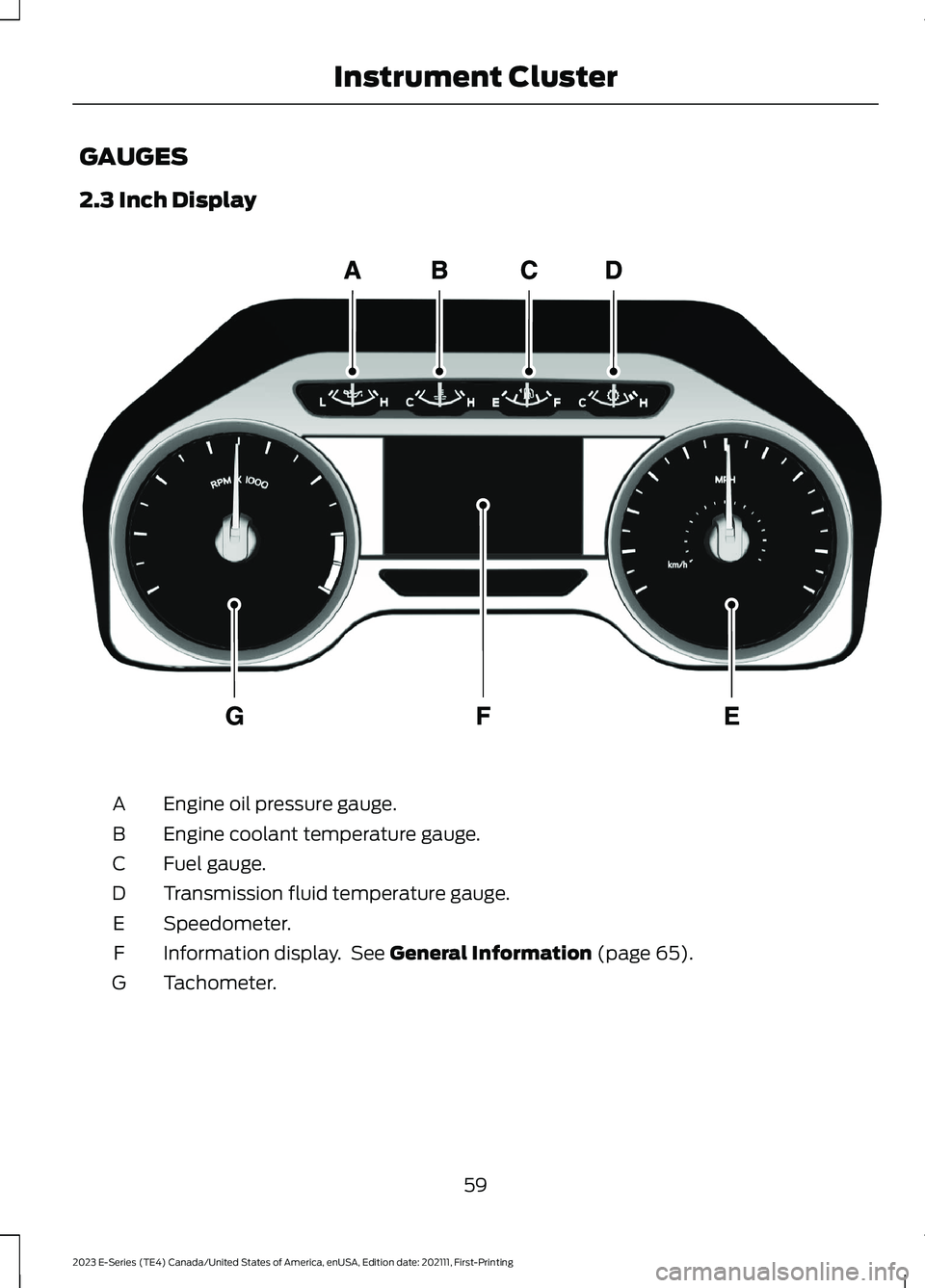
GAUGES
2.3 Inch Display
Engine oil pressure gauge.A
Engine coolant temperature gauge.B
Fuel gauge.C
Transmission fluid temperature gauge.D
Speedometer.E
Information display. See General Information (page 65).F
Tachometer.G
59
2023 E-Series (TE4) Canada/United States of America, enUSA, Edition date: 202111, First-PrintingInstrument ClusterE219638
Page 63 of 292
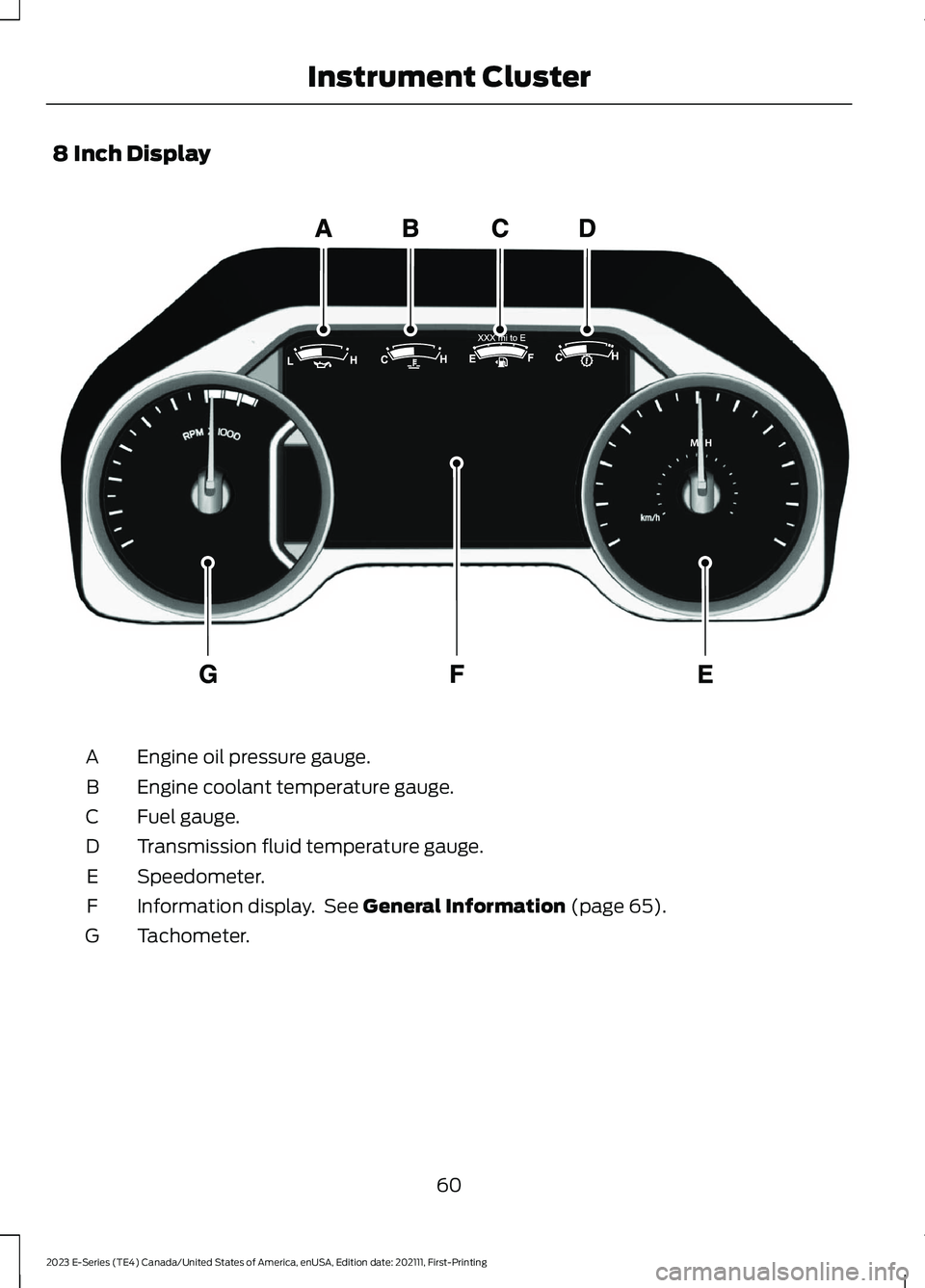
8 Inch Display
Engine oil pressure gauge.A
Engine coolant temperature gauge.B
Fuel gauge.C
Transmission fluid temperature gauge.D
Speedometer.E
Information display. See General Information (page 65).F
Tachometer.G
60
2023 E-Series (TE4) Canada/United States of America, enUSA, Edition date: 202111, First-PrintingInstrument ClusterE299699
Page 64 of 292
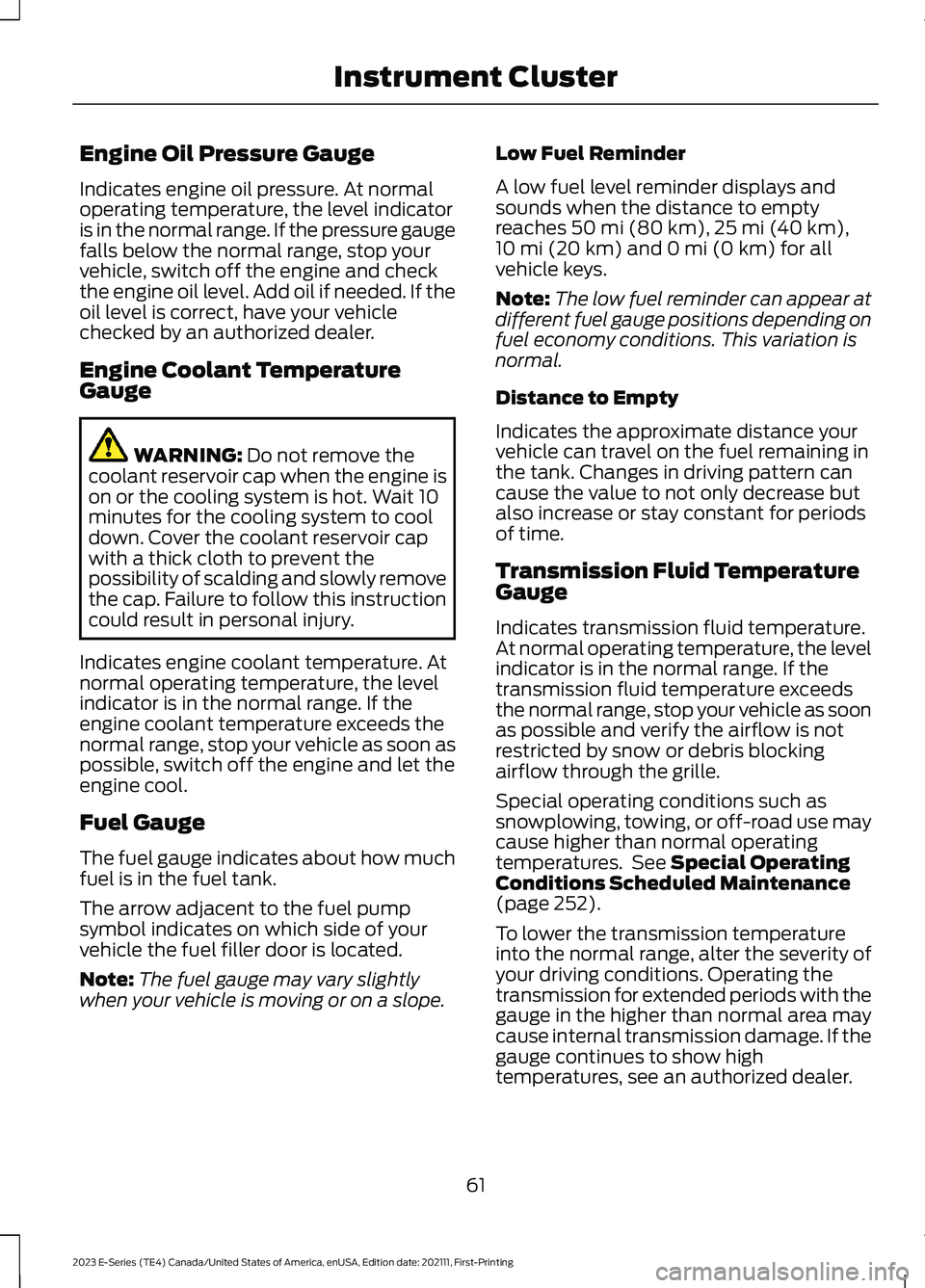
Engine Oil Pressure Gauge
Indicates engine oil pressure. At normaloperating temperature, the level indicatoris in the normal range. If the pressure gaugefalls below the normal range, stop yourvehicle, switch off the engine and checkthe engine oil level. Add oil if needed. If theoil level is correct, have your vehiclechecked by an authorized dealer.
Engine Coolant TemperatureGauge
WARNING: Do not remove thecoolant reservoir cap when the engine ison or the cooling system is hot. Wait 10minutes for the cooling system to cooldown. Cover the coolant reservoir capwith a thick cloth to prevent thepossibility of scalding and slowly removethe cap. Failure to follow this instructioncould result in personal injury.
Indicates engine coolant temperature. Atnormal operating temperature, the levelindicator is in the normal range. If theengine coolant temperature exceeds thenormal range, stop your vehicle as soon aspossible, switch off the engine and let theengine cool.
Fuel Gauge
The fuel gauge indicates about how muchfuel is in the fuel tank.
The arrow adjacent to the fuel pumpsymbol indicates on which side of yourvehicle the fuel filler door is located.
Note:The fuel gauge may vary slightlywhen your vehicle is moving or on a slope.
Low Fuel Reminder
A low fuel level reminder displays andsounds when the distance to emptyreaches 50 mi (80 km),25 mi (40 km),10 mi (20 km) and 0 mi (0 km) for allvehicle keys.
Note:The low fuel reminder can appear atdifferent fuel gauge positions depending onfuel economy conditions. This variation isnormal.
Distance to Empty
Indicates the approximate distance yourvehicle can travel on the fuel remaining inthe tank. Changes in driving pattern cancause the value to not only decrease butalso increase or stay constant for periodsof time.
Transmission Fluid TemperatureGauge
Indicates transmission fluid temperature.At normal operating temperature, the levelindicator is in the normal range. If thetransmission fluid temperature exceedsthe normal range, stop your vehicle as soonas possible and verify the airflow is notrestricted by snow or debris blockingairflow through the grille.
Special operating conditions such assnowplowing, towing, or off-road use maycause higher than normal operatingtemperatures. See Special OperatingConditions Scheduled Maintenance(page 252).
To lower the transmission temperatureinto the normal range, alter the severity ofyour driving conditions. Operating thetransmission for extended periods with thegauge in the higher than normal area maycause internal transmission damage. If thegauge continues to show hightemperatures, see an authorized dealer.
61
2023 E-Series (TE4) Canada/United States of America, enUSA, Edition date: 202111, First-PrintingInstrument Cluster
Page 71 of 292

Vehicle Info
Vehicle Info
Gauge View
Digital Speedometer
Engine Information
Maintenance Monitor
Transmission Temp
•Engine Information - Shows engine hours, engine idle hours and engine oil temp andoil life.
Settings
Settings
Turn On or OffDriver Alert
Select Your SettingPre-Collision
Select Your SettingCruiseControl
Select Your SettingGauge Selec-tion
Select Your SettingLightingVehicleAdvancedSettingsLocks
FordPass
Windows
Wiper Controls
Select Your SettingUnitsDispl.SettingsTemperature
Tire Pressure
Language
68
2023 E-Series (TE4) Canada/United States of America, enUSA, Edition date: 202111, First-PrintingInformation Displays
Page 97 of 292

Illumination of the service engine soonindicator, charging system warning light orthe temperature warning light, fluid leaks,strange odors, smoke or loss of enginepower could indicate that the emissioncontrol system is not working properly.
An improperly operating or damagedexhaust system may allow exhaust toenter the vehicle. Have a damaged orimproperly operating exhaust systeminspected and repaired immediately.
Do not make any unauthorized changes toyour vehicle or engine. By law, vehicleowners and anyone who manufactures,repairs, services, sells, leases, tradesvehicles, or supervises a fleet of vehiclesare not permitted to intentionally removean emission control device or prevent itfrom working. Information about yourvehicle’s emission system is on the VehicleEmission Control Information Decallocated on or near the engine. This decalalso lists engine displacement.
Please consult your warranty informationfor complete details.
On-Board Diagnostics (OBD-II)
Your vehicle has a computer known as theon-board diagnostics system (OBD-II) thatmonitors the engine’s emission controlsystem. The system protects theenvironment by making sure that yourvehicle continues to meet governmentemission standards. The OBD-II systemalso assists a service technician in properlyservicing your vehicle.
When the service engine soonindicator illuminates, the OBD-IIsystem has detected amalfunction. Temporary malfunctions maycause the service engine soon indicator toilluminate. Examples are:
1.Your vehicle has run out of fuel—theengine may misfire or run poorly.
2.Poor fuel quality or water in thefuel—the engine may misfire or runpoorly.
3.The fuel fill inlet may not have closedproperly. See Refueling (page 89).
4.Driving through deep water—theelectrical system may be wet.
You can correct these temporarymalfunctions by filling the fuel tank withgood quality fuel, properly closing the fuelfill inlet or letting the electrical system dryout. After three driving cycles without theseor any other temporary malfunctionspresent, the service engine soon indicatorshould stay off the next time you start theengine. A driving cycle consists of a coldengine startup followed by mixed city andhighway driving. No additional vehicleservice is required.
If the service engine soon indicator remainson, have your vehicle serviced at the firstavailable opportunity. Although somemalfunctions detected by the OBD-II maynot have symptoms that are apparent,continued driving with the service enginesoon indicator on can result in increasedemissions, lower fuel economy, reducedengine and transmission smoothness andlead to more costly repairs.
Readiness for Inspection andMaintenance (I/M) Testing
Some state and provincial and localgovernments may haveInspection/Maintenance (I/M) programsto inspect the emission control equipmenton your vehicle. Failure to pass thisinspection could prevent you from gettinga vehicle registration.
If the service engine soonindicator is on or the bulb doesnot work, your vehicle may needservice. See On-Board Diagnostics.
94
2023 E-Series (TE4) Canada/United States of America, enUSA, Edition date: 202111, First-PrintingEngine Emission Control
Page 166 of 292

UNDER HOOD OVERVIEW
Windshield washer fluid reservoir. See Washer Fluid Check (page 177).A
Automatic transmission fluid dipstick. See Automatic Transmission FluidCheck (page 170).B
Engine oil dipstick. See Engine Oil Dipstick (page 164).C
Air cleaner assembly. See Changing the Engine Air Filter (page 165).D
Engine oil filler cap. See Engine Oil Check (page 164).E
Brake fluid reservoir. See Brake Fluid Check (page 173).F
Engine coolant reservoir. See Engine Coolant Check (page 166).G
Engine compartment fuse box. See Fuses (page 152).H
Power steering fluid reservoir. See Power Steering Fluid Check (page 174).I
Battery. See Changing the 12V Battery (page 174).J
163
2023 E-Series (TE4) Canada/United States of America, enUSA, Edition date: 202111, First-PrintingMaintenanceE312299
Page 228 of 292
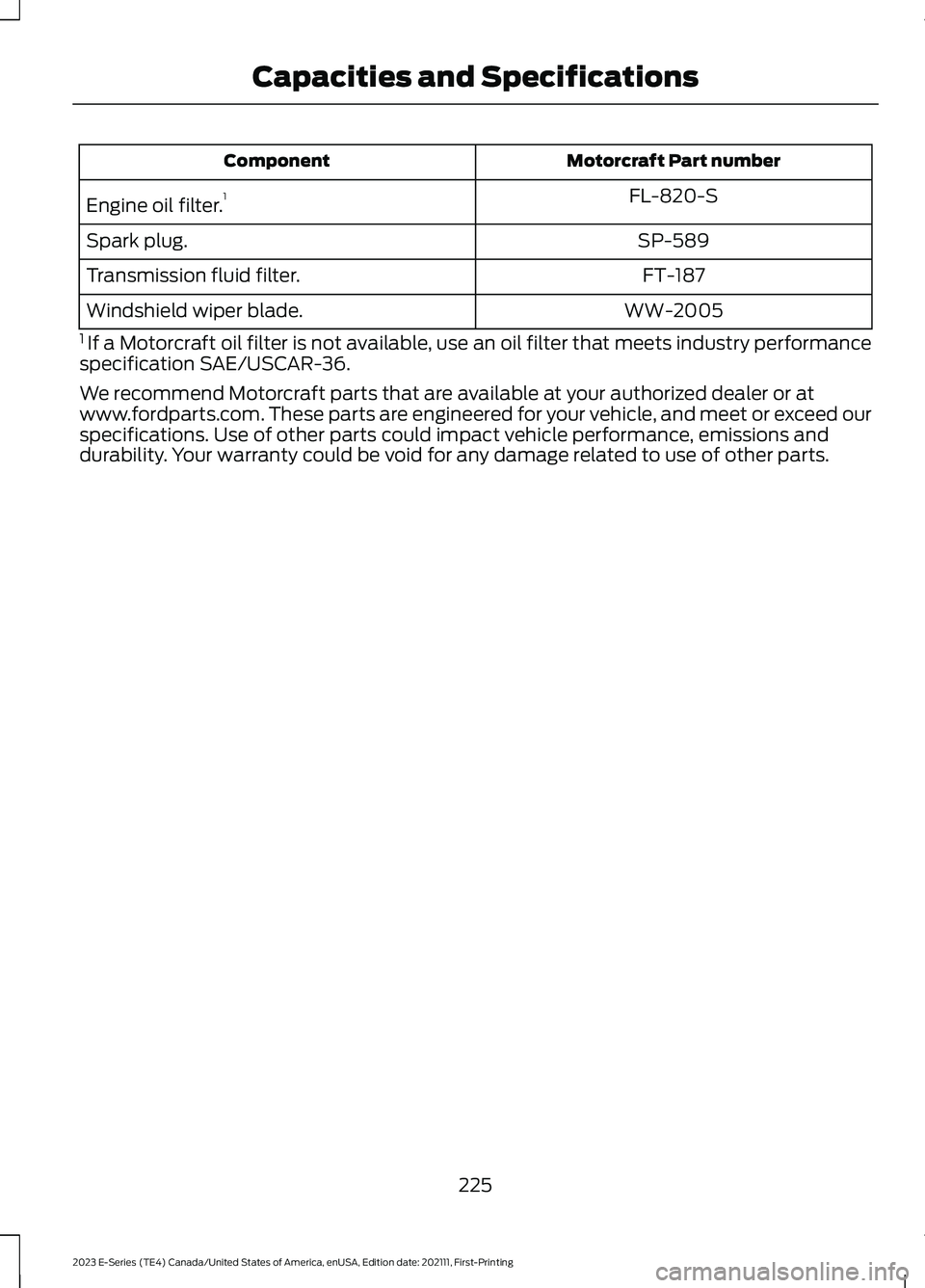
Motorcraft Part numberComponent
FL-820-SEngine oil filter.1
SP-589Spark plug.
FT-187Transmission fluid filter.
WW-2005Windshield wiper blade.
1 If a Motorcraft oil filter is not available, use an oil filter that meets industry performancespecification SAE/USCAR-36.
We recommend Motorcraft parts that are available at your authorized dealer or atwww.fordparts.com. These parts are engineered for your vehicle, and meet or exceed ourspecifications. Use of other parts could impact vehicle performance, emissions anddurability. Your warranty could be void for any damage related to use of other parts.
225
2023 E-Series (TE4) Canada/United States of America, enUSA, Edition date: 202111, First-PrintingCapacities and Specifications
Page 252 of 292
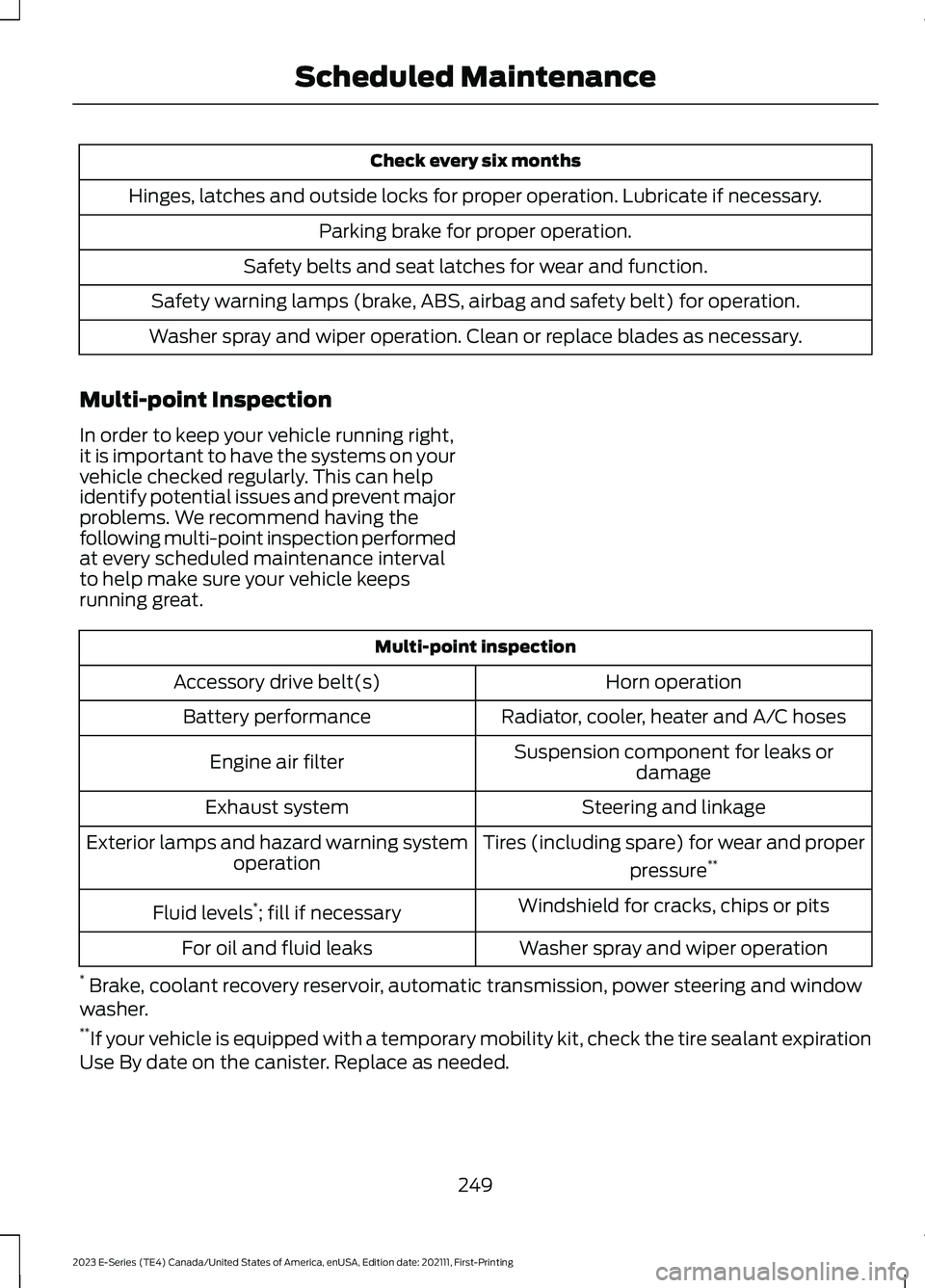
Check every six months
Hinges, latches and outside locks for proper operation. Lubricate if necessary.
Parking brake for proper operation.
Safety belts and seat latches for wear and function.
Safety warning lamps (brake, ABS, airbag and safety belt) for operation.
Washer spray and wiper operation. Clean or replace blades as necessary.
Multi-point Inspection
In order to keep your vehicle running right,it is important to have the systems on yourvehicle checked regularly. This can helpidentify potential issues and prevent majorproblems. We recommend having thefollowing multi-point inspection performedat every scheduled maintenance intervalto help make sure your vehicle keepsrunning great.
Multi-point inspection
Horn operationAccessory drive belt(s)
Radiator, cooler, heater and A/C hosesBattery performance
Suspension component for leaks ordamageEngine air filter
Steering and linkageExhaust system
Tires (including spare) for wear and proper
pressure**Exterior lamps and hazard warning systemoperation
Windshield for cracks, chips or pitsFluid levels*; fill if necessary
Washer spray and wiper operationFor oil and fluid leaks
* Brake, coolant recovery reservoir, automatic transmission, power steering and windowwasher.**If your vehicle is equipped with a temporary mobility kit, check the tire sealant expirationUse By date on the canister. Replace as needed.
249
2023 E-Series (TE4) Canada/United States of America, enUSA, Edition date: 202111, First-PrintingScheduled Maintenance